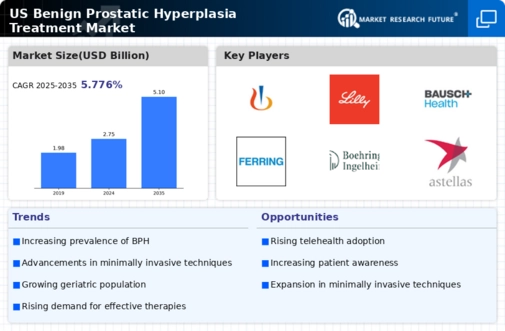The US Benign Prostatic Hyperplasia Treatment Market is characterized by a dynamic and competitive landscape driven by increasing prevalence rates, advanced treatment options, and a growing awareness of the condition among healthcare providers and patients. Innovations in pharmaceuticals and minimally invasive surgical procedures have transformed the therapeutic approaches for benign prostatic hyperplasia (BPH), leading to enhanced patient outcomes and quality of life. Key players in this market are focusing on research and development to deliver effective therapies, while also exploring collaborations and strategic partnerships to expand their product portfolios and market reach.
The competitive environment is marked by a mix of established pharmaceutical companies and emerging players, each vying for market share through differentiation and agility in response to changing market needs.
Merck and Co has established a strong presence in the US Benign Prostatic Hyperplasia Treatment Market, powered by its commitment to research and the development of novel treatment options. The company leverages its robust pipeline to offer treatments that not only alleviate symptoms of BPH but also address underlying causes. Merck's efforts in clinical trials and collaborations with healthcare institutions help to solidify its standing and enhance its credibility within the medical community. The reliability and efficiency of its products have garnered favorable perceptions among healthcare professionals and patients alike, contributing positively to the company's market growth.
Moreover, Merck's extensive distribution and marketing networks enable it to effectively reach a broader audience, ensuring that its treatments are accessible to patients in various healthcare settings across the United States.
Novartis has made significant inroads into the US Benign Prostatic Hyperplasia Treatment Market through strategic investments and innovative therapies tailored to manage the condition effectively. The company’s key products in this space focus on addressing the multifaceted aspects of BPH, including symptom relief and long-term management strategies. Novartis is acknowledged for its contributions to clinical research, which enhances its credibility as a leading player in the field. The organization is also recognized for its strategic mergers and acquisitions, bolstering its capabilities and expanding its product portfolio within the US market.
With a focus on patient-centric approaches, Novartis successfully aligns its offerings to meet the needs of a diverse patient population. This flexibility, combined with a formidable research infrastructure, underscores the company’s strengths and its ongoing dedication to making a meaningful impact in the treatment landscape for benign prostatic hyperplasia.












